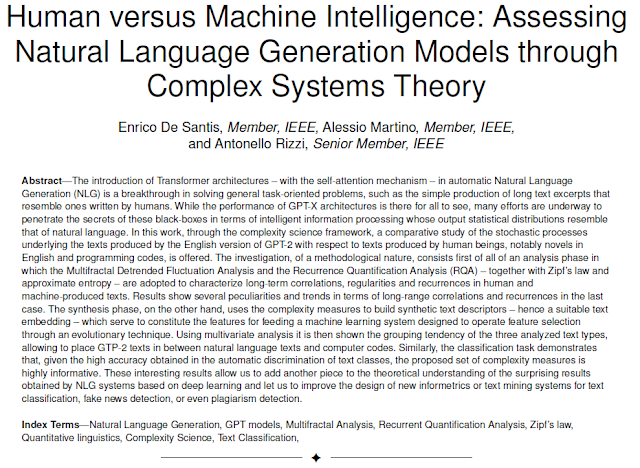Introduction
The paper addresses the increasing presence of machine-generated texts in various domains, contrasting them with human-generated texts. It introduces methods to quantitatively evaluate and compare the complexity and characteristics of these texts.
1. Background and Motivation
The section explores the motivation behind comparing human and machine intelligence through text analysis. It highlights the importance of understanding the intricacies of machine-generated texts, especially with advancements in NLP technologies such as GPT-2.
2. Complexity Measures
This section outlines various complexity measures used to evaluate texts. These measures include:
- Hurst Exponent (H): Indicates the long-term memory of the text.
- Recurrence Rate (RR): Measures the frequency of repetitive patterns.
- Determinism (DET): Captures the predictability of the text.
- Entropy (ENTR): Reflects the randomness.
- Laminarity (LAM): Measures the tendency of the text to form laminar patterns.
- Trapping Time (TT): Indicates the duration of repetitive patterns.
- Zipf’s Law Parameters: Analyzes the frequency distribution of words.
3. Data Collection
The corpus comprises 212 texts divided into three categories: English literature (ENG), machine-generated texts by GPT-2 (GPT-2), and programming codes (LINUX). Each text is represented by a feature vector derived from the complexity measures.
4. Methodology
The authors employ a Support Vector Machine (SVM) for classification tasks to discriminate between the three text categories. The feature vectors are normalized, and a genetic algorithm optimizes the SVM's hyperparameters.
5. Experimental Results
The results indicate that the complexity measures effectively differentiate between human and machine-generated texts. The SVM achieves high accuracy, demonstrating the distinct characteristics of the three categories. The dendrogram analysis reveals the closeness of novels with GPT-2 texts compared to programming codes.
6. Discussion
The discussion emphasizes the relevance of the complexity measures in characterizing different types of texts. It highlights the potential of these measures to serve as indicators of text originality and authorship. The authors suggest that further research could explore the application of these measures in various domains, including plagiarism detection and content authenticity verification.
7. Conclusion
The paper concludes by affirming the utility of complexity measures in distinguishing human and machine intelligence. It underscores the need for continued exploration of these metrics to enhance our understanding of machine-generated texts and their implications.
Final Resume and Main Considerations
The authors conclude that complexity measures offer a robust framework for distinguishing between human and machine-generated texts. The study demonstrates that features such as entropy, determinism, and Zipf's law parameters are effective in capturing the inherent differences in text structure and complexity. The use of SVM for classification further validates the distinctiveness of these features.
The main considerations from the paper are:
- Quantitative Evaluation: Complexity measures provide a quantitative approach to evaluating and comparing texts, bridging the gap between qualitative assessments and statistical analysis.
- Machine Intelligence Understanding: The study enhances our understanding of how machine-generated texts differ from human texts, contributing to the broader field of AI and machine learning.
- Future Research: There is significant potential for applying these measures in various practical applications, including detecting machine-generated content, verifying content authenticity, and studying the evolution of machine intelligence.
The authors advocate for continued research into complexity measures and their applications, emphasizing their relevance in the ever-evolving landscape of artificial intelligence and natural language processing.
Source paper: https://www.computer.org/csdl/journal/tp/2024/07/10413606/1TY3NewpqGQ




No comments:
Post a Comment